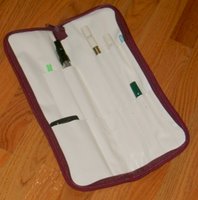I'm in Scotts Valley, CA for a week to meet with some folks at Borland, and as I had a free day yesterday I decided to look for a session. It turns out that there are quite a few sessions in the Santa Cruz area but the only one I could make during my trip was the second Sunday slow/intermediate session meeting at the Britannia Arms Pub in Aptos.
Like the session I attend in Columbus, it was very friendly, somewhat informal, and welcoming to beginners. When I entered the pub I sat down outside the circle to try and get a feel for the session before joining in. Someone spotted my whistle case, however, and asked me to join almost as soon as I sat down, and then almost immediately invited me to start a tune. I found it to be a very welcoming group. As chance would have it, I had attended Sunday services at the Unitarian Universalist church in Aptos that morning and found it to be a very outgoing and warm group as well, so maybe there are just a lot of nice people in the Aptos area....
But there were differences from the Columbus session, as well. For one thing, the mix of instruments was different. In Columbus we have enough fiddles to stock a symphony orchestra, whereas there were only two fiddlers in Aptos, but three people played mandolins, making them the most common instrument in the session. Someone also brought a cello, which was neat. More significantly (though not surprisingly), the tunes were different. I recognized nearly all of them, but even when I knew how to play the tune they sometimes played it differently; the folks in Aptos play Sí bheag Sí mhor with repeats, whereas I've always played it straight through. It threw me off a bit until I figured out what they were doing, and then I could keep up. When I was invited to start tunes it took a little comparison of notes to find some that both I and the rest of the session knew, but after some discussion I ended up starting Harvest Home and the Swallowtail Jig.
This was the first time I've attended a session while traveling, and it was a great experience, both because the folks in the session were so nice and because it was challenging for me to keep up with musicians who do things differently than I'm used to. That's a good thing; it's always good practice to listen. I'm certainly going to seek out sessions when I travel in the future.
Anyone know of a session meeting next week in Santa Fe?


